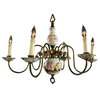
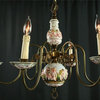
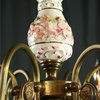
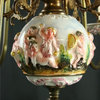
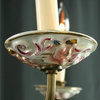
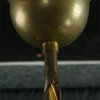
Item 1 of 6








Item 1 of 6


- Product Description
- Product Specifications
- Shipping and Returns
Product Details
- Item #: 15-191
- Dimensions (inches): 23H x 30.50W x 30.50D
- From Ceiling 7H
- Comment: Make a splash anywhere in your decor with this adorable vintage Capodimonte chandelier adorned with frolicking cherubs! In various scenes on the ceramic body, winged putti share fruit and hike with knapsacks. The candle holders also feature our charming fellows in various states of play. Bringing the scenes to life are pastel colors in shades ranging from the sky's soft blue to a blush pink. Dating to 1950, this Capodimonte chandelier features a relatively rare design that doesn't become available very often. This sweet Italian chandelier will look darling in your living room or a child's bedroom. The fixture measures over 30 inches in diameter by 23 inches high and has 6 arms to provide ample lighting. Add these charming cherubs to your decor before they're gone!
- Origin: Italy
- Date: 1950
- Material: Ceramic, Metal
- CERAMIC
- The word ceramic originates from the ancient Greek word keramikos, meaning potteres clay. The practice of making ceramics has been in existence for nearly 30,000 years. Clay, the primary ingredient for any ceramic, is primarily made of aluminum silicate, which is a malleable soil from crumbling rocks. Ceramics can be grouped according to the type of clay used, the temperature at which the clay is fired, and the duration of the firing. ,
- METAL
- As it is often difficult to determine the exact composition of metal objects due to the prevalent use of metal plating and alloys, EuroLux Antiques uses the term metal rather than the more specific terms copper, brass, aluminum, steel, etc. for its listings in order to avoid confusion.
- Bulb Included: 0
- Bulb Quantity: 6
- Availability: Available for Immediate Shipment.
- Condition
- Condition: GOOD
- In overall good condition. Antique and vintage items by their very nature show normal wear to finish and miscellaneous scratches, nicks, and dings due to age and use. As we define 'good condition' relative to the stated age of the piece, we would expect to see 'character marks' consistent with that age and could include nicks or dings to a wooden, metal, enamel, or chalkware object, wear to a painted surface, speckling on a mirror, crazing, wear to gilding, or manufacturing glaze skips in ceramic finish, wear to a label, and some original decorative trim may be missing. If ceramic/porcelain restoration has been done, it is of museum-quality so that it is hardly discernible and would be specifically mentioned in the listing. 'Good condition' could include very small fleabite chips or very small hairline cracks in any glass, ceramic, or marble item, but these would be specifically mentioned in the listing.
- Item Specifics: Shows normal wear to the metal finish and minor crazing to the ceramic finish. There is a crack in the decorative metal band around the candle on one arm and fleabites to the top edges of the ceramic bobeches, neither of which is visible from the floor.
- Shipping
- This Item Ships Free within the Contiguous 48 United States and this item will be shipped via Vanline. Vanline shipments generally take between 4-8 business weeks after being picked up by the vanline at the EuroLux Gallery. Delivery times may vary depending on your exact location and the current schedule of our preferred vanline.
Additional Information
- Mark: EuroLux Home
- Style: Capodimonte CAPODIMONTE (aka Capo Di Monte)
- The most famous porcelain manufacturer in Italy was Capodimonte, which was founded in 1736 at the Royal Court in Naples. Charles VII (1738 e 1759), son of Philip V of Spain, married Maria Amalia, granddaughter of Augustus II of Poland, founder of the Meissen porcelain factory in Germany. Charles VII wanted to create a porcelain factory in Italy that would rival that of Meissen. Without much initial success, he built a larger factory in 1743 in the Royal Wood of Capodimonte. Upon the death of Philip V, Charles moved to Spain to ascend the throne as Charles III of Spain and moved the entire production with him to Madrid, including all the molds and the skilled artists. Eventually Ferdinand IV King of Naples (1759 e 1816) returned the porcelain manufacture to Naples, where it continued as a royal factory until 1807. The high-quality works were in great demand throughout Europe. At that time, it was sold to a commercial corporation, which later closed in 1821. The business, including the original molds, was divided and sold in lots to several companies that still use the molds and the Capodimonte mark of a crown with a blue N today. Two of these companies are Doccia and Societe Richard Ceramica, also known as Ginori.
- Capodimonte was extremely influential in Italy and many Italian potters imitated their designs, especially those with flowers and mythological scenes. In modern usage today, Capodimonte denotes ceramics made in the general style and fashion of those made by the 18th century Neapolitan porcelain manufacturer, although most pieces today are not made of porcelain. A great many of these pieces were made in the 1950s and 1960s. Many of these Capodimonte style pieces are marked Bassano (a city focused on ceramic production in the Marche region) or simply Italy, or even without a mark at all.
- Object: Chandelier
Large Consigned Vintage Capodimonte Chandelier 1950
Product Details
- Item #: 15-191
- Dimensions (inches): 23H x 30.50W x 30.50D
- From Ceiling 7H
- Comment: Make a splash anywhere in your decor with this adorable vintage Capodimonte chandelier adorned with frolicking cherubs! In various scenes on the ceramic body, winged putti share fruit and hike with knapsacks. The candle holders also feature our charming fellows in various states of play. Bringing the scenes to life are pastel colors in shades ranging from the sky's soft blue to a blush pink. Dating to 1950, this Capodimonte chandelier features a relatively rare design that doesn't become available very often. This sweet Italian chandelier will look darling in your living room or a child's bedroom. The fixture measures over 30 inches in diameter by 23 inches high and has 6 arms to provide ample lighting. Add these charming cherubs to your decor before they're gone!
- Origin: Italy
- Date: 1950
- Material: Ceramic, Metal
- CERAMIC
- The word ceramic originates from the ancient Greek word keramikos, meaning potteres clay. The practice of making ceramics has been in existence for nearly 30,000 years. Clay, the primary ingredient for any ceramic, is primarily made of aluminum silicate, which is a malleable soil from crumbling rocks. Ceramics can be grouped according to the type of clay used, the temperature at which the clay is fired, and the duration of the firing. ,
- METAL
- As it is often difficult to determine the exact composition of metal objects due to the prevalent use of metal plating and alloys, EuroLux Antiques uses the term metal rather than the more specific terms copper, brass, aluminum, steel, etc. for its listings in order to avoid confusion.
- Bulb Included: 0
- Bulb Quantity: 6
- Availability: Available for Immediate Shipment.
- Condition
- Condition: GOOD
- In overall good condition. Antique and vintage items by their very nature show normal wear to finish and miscellaneous scratches, nicks, and dings due to age and use. As we define 'good condition' relative to the stated age of the piece, we would expect to see 'character marks' consistent with that age and could include nicks or dings to a wooden, metal, enamel, or chalkware object, wear to a painted surface, speckling on a mirror, crazing, wear to gilding, or manufacturing glaze skips in ceramic finish, wear to a label, and some original decorative trim may be missing. If ceramic/porcelain restoration has been done, it is of museum-quality so that it is hardly discernible and would be specifically mentioned in the listing. 'Good condition' could include very small fleabite chips or very small hairline cracks in any glass, ceramic, or marble item, but these would be specifically mentioned in the listing.
- Item Specifics: Shows normal wear to the metal finish and minor crazing to the ceramic finish. There is a crack in the decorative metal band around the candle on one arm and fleabites to the top edges of the ceramic bobeches, neither of which is visible from the floor.
- Shipping
- This Item Ships Free within the Contiguous 48 United States and this item will be shipped via Vanline. Vanline shipments generally take between 4-8 business weeks after being picked up by the vanline at the EuroLux Gallery. Delivery times may vary depending on your exact location and the current schedule of our preferred vanline.
Additional Information
- Mark: EuroLux Home
- Style: Capodimonte CAPODIMONTE (aka Capo Di Monte)
- The most famous porcelain manufacturer in Italy was Capodimonte, which was founded in 1736 at the Royal Court in Naples. Charles VII (1738 e 1759), son of Philip V of Spain, married Maria Amalia, granddaughter of Augustus II of Poland, founder of the Meissen porcelain factory in Germany. Charles VII wanted to create a porcelain factory in Italy that would rival that of Meissen. Without much initial success, he built a larger factory in 1743 in the Royal Wood of Capodimonte. Upon the death of Philip V, Charles moved to Spain to ascend the throne as Charles III of Spain and moved the entire production with him to Madrid, including all the molds and the skilled artists. Eventually Ferdinand IV King of Naples (1759 e 1816) returned the porcelain manufacture to Naples, where it continued as a royal factory until 1807. The high-quality works were in great demand throughout Europe. At that time, it was sold to a commercial corporation, which later closed in 1821. The business, including the original molds, was divided and sold in lots to several companies that still use the molds and the Capodimonte mark of a crown with a blue N today. Two of these companies are Doccia and Societe Richard Ceramica, also known as Ginori.
- Capodimonte was extremely influential in Italy and many Italian potters imitated their designs, especially those with flowers and mythological scenes. In modern usage today, Capodimonte denotes ceramics made in the general style and fashion of those made by the 18th century Neapolitan porcelain manufacturer, although most pieces today are not made of porcelain. A great many of these pieces were made in the 1950s and 1960s. Many of these Capodimonte style pieces are marked Bassano (a city focused on ceramic production in the Marche region) or simply Italy, or even without a mark at all.
- Object: Chandelier
- Product ID
- 12651824
- Sold By
- EuroLuxHome
- Size
- W 30.5" / D 30.5" / H 23"
- Materials
- Ceramic, Metal
- Category
- Chandeliers
- Style
- Traditional
- Product Description
- Product Specifications
- Shipping and Returns
Product Details
- Item #: 15-191
- Dimensions (inches): 23H x 30.50W x 30.50D
- From Ceiling 7H
- Comment: Make a splash anywhere in your decor with this adorable vintage Capodimonte chandelier adorned with frolicking cherubs! In various scenes on the ceramic body, winged putti share fruit and hike with knapsacks. The candle holders also feature our charming fellows in various states of play. Bringing the scenes to life are pastel colors in shades ranging from the sky's soft blue to a blush pink. Dating to 1950, this Capodimonte chandelier features a relatively rare design that doesn't become available very often. This sweet Italian chandelier will look darling in your living room or a child's bedroom. The fixture measures over 30 inches in diameter by 23 inches high and has 6 arms to provide ample lighting. Add these charming cherubs to your decor before they're gone!
- Origin: Italy
- Date: 1950
- Material: Ceramic, Metal
- CERAMIC
- The word ceramic originates from the ancient Greek word keramikos, meaning potteres clay. The practice of making ceramics has been in existence for nearly 30,000 years. Clay, the primary ingredient for any ceramic, is primarily made of aluminum silicate, which is a malleable soil from crumbling rocks. Ceramics can be grouped according to the type of clay used, the temperature at which the clay is fired, and the duration of the firing. ,
- METAL
- As it is often difficult to determine the exact composition of metal objects due to the prevalent use of metal plating and alloys, EuroLux Antiques uses the term metal rather than the more specific terms copper, brass, aluminum, steel, etc. for its listings in order to avoid confusion.
- Bulb Included: 0
- Bulb Quantity: 6
- Availability: Available for Immediate Shipment.
- Condition
- Condition: GOOD
- In overall good condition. Antique and vintage items by their very nature show normal wear to finish and miscellaneous scratches, nicks, and dings due to age and use. As we define 'good condition' relative to the stated age of the piece, we would expect to see 'character marks' consistent with that age and could include nicks or dings to a wooden, metal, enamel, or chalkware object, wear to a painted surface, speckling on a mirror, crazing, wear to gilding, or manufacturing glaze skips in ceramic finish, wear to a label, and some original decorative trim may be missing. If ceramic/porcelain restoration has been done, it is of museum-quality so that it is hardly discernible and would be specifically mentioned in the listing. 'Good condition' could include very small fleabite chips or very small hairline cracks in any glass, ceramic, or marble item, but these would be specifically mentioned in the listing.
- Item Specifics: Shows normal wear to the metal finish and minor crazing to the ceramic finish. There is a crack in the decorative metal band around the candle on one arm and fleabites to the top edges of the ceramic bobeches, neither of which is visible from the floor.
- Shipping
- This Item Ships Free within the Contiguous 48 United States and this item will be shipped via Vanline. Vanline shipments generally take between 4-8 business weeks after being picked up by the vanline at the EuroLux Gallery. Delivery times may vary depending on your exact location and the current schedule of our preferred vanline.
Additional Information
- Mark: EuroLux Home
- Style: Capodimonte CAPODIMONTE (aka Capo Di Monte)
- The most famous porcelain manufacturer in Italy was Capodimonte, which was founded in 1736 at the Royal Court in Naples. Charles VII (1738 e 1759), son of Philip V of Spain, married Maria Amalia, granddaughter of Augustus II of Poland, founder of the Meissen porcelain factory in Germany. Charles VII wanted to create a porcelain factory in Italy that would rival that of Meissen. Without much initial success, he built a larger factory in 1743 in the Royal Wood of Capodimonte. Upon the death of Philip V, Charles moved to Spain to ascend the throne as Charles III of Spain and moved the entire production with him to Madrid, including all the molds and the skilled artists. Eventually Ferdinand IV King of Naples (1759 e 1816) returned the porcelain manufacture to Naples, where it continued as a royal factory until 1807. The high-quality works were in great demand throughout Europe. At that time, it was sold to a commercial corporation, which later closed in 1821. The business, including the original molds, was divided and sold in lots to several companies that still use the molds and the Capodimonte mark of a crown with a blue N today. Two of these companies are Doccia and Societe Richard Ceramica, also known as Ginori.
- Capodimonte was extremely influential in Italy and many Italian potters imitated their designs, especially those with flowers and mythological scenes. In modern usage today, Capodimonte denotes ceramics made in the general style and fashion of those made by the 18th century Neapolitan porcelain manufacturer, although most pieces today are not made of porcelain. A great many of these pieces were made in the 1950s and 1960s. Many of these Capodimonte style pieces are marked Bassano (a city focused on ceramic production in the Marche region) or simply Italy, or even without a mark at all.
- Object: Chandelier
At Houzz we want you to shop for Large Consigned Vintage Capodimonte Chandelier 1950 with confidence. You can read real customer reviews for this or any other product and even ask questions and get answers from us or straight from the brand. When you buy Large Consigned Vintage Capodimonte Chandelier 1950 or any product product online from us, you become part of the Houzz family and can expect exceptional customer service every step of the way. If you have questions about or any other product for sale, our customer service team is eager to help.
Browse over 25 million home design photos on Houzz







